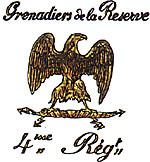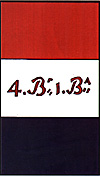'Les Grenadiers de la Reserve'
Organization, Uniforms, and Colours
by Stephen Ede-Borrett, UK
| |
These notes which will I trust prove of interest and use to those interested in Napoleonic ephemera, were inspired by Jim Gaskill's letter and query regarding "Line Grenadier Battalions" in First Empire 29. My first thoughts upon reading Mr Gaskill's enquiry was to consult my collection with a particular eye on the proviso of "English Language". I was, to say the least, surprised by what I found - to be frank, absolutely nothing in any the generally, available works; not even in George Nafziger's The French Army: Royal Republican & Imperial, 1788-1815 (Parts 1 to 3, Leeds 1987. These were, in fact, the only three parts of this planned eight part series to he published). Hence I concluded that there might be enough interest in these formations for our Editor to publish this article (which if you are reading this and are not me, then there obviously was). The Order of Battle of the French Army of the Napoleonic era did not contain any 'Grenadier Battalions' 1 but there was clearly a need for an elite reserve for the future Grande Armée for on 22nd November 1803 the First Consul took the decision to organise twelve elite battalions from the regiments not destined for the invasion of England. In January 1804 it was decreed that these twelve battalions were to be organised as six, two-battalion regiments, each battalion to be of six companies. The whole formation was to form a Reserve Division entitled "Les Grenadiers de la Reserve" under General Junot.
In fact the Grenadiers de la Reserve were not formed entirely of elite companies - each battalion actually consisted of three elite companies and three especially chosen fusilier or chasseur companies from the same formations as the elite companies. The actual organisation was as follows:
It should perhaps be noted that with the exception of the 2e and 12e Leger, which had been reduced to two battalion strength in 1801 2 all of these regiments were three battalion formations and could thus contribute a theoretical three elite companies each since there was, as yet, only one elite company per battalion.
The organisation of this division changed in March 1805 and command passed to General Oudinot:
This revised division fought throughout the 1805 campaign but at Austerlitz (2nd December) it was commanded by Duroc as Oudinot had not fully recovered from the wound that he had received at Hollabrunn on 15 - 16 November. After the 9th December the regiments were broken up piecemeal and the companies posted back to their parent regiments. The Grenadiers de la Reserve were formally disbanded on lst July 1806.
Napoleon was obviously pleased with the performance of Oudinot's division because on 21st October 1806 (seven days after Jena-Auerstädt) he decreed the organisation of the 'Grenadiers et Voltigeurs reunis' 3 (from lst March 1807 the division was again entitled the Grenadiers de la Reserve) - more usually called "Les Grenadiers D'Oudinot|"
This new division was to be of seven (later eight) regiments, each of two battalions, each of six companies. All companies were elites drawn from the depot battalions of regiments with the Grande Armée – two companies each from 48 battalions!
Initially the two elite companies of each unit served alongside each other but from July 1807 all the grenadier companies were grouped into the 1st battalions and all the voltigeur companies into the 2nd.
The regiments whose depots provided the companies were: -
Legere: 6e, 7e, 9e, 10e, 16e, 17e, 21e, 24e, 25e, 26e, 27e, 28e. The exact composition of companies comprising each battalion was not stable and there are known to have been movements of pairs of elite companies - in one case the two companies of the 23e went from the 2e Regiment to the 8e, whilst the two elites of the 61e went from the 8e Regiment to the 2e (a case of bad blood between companies brigaded together?)
In January 1808 the elite companies of the 3e, 14e, 44e, 51e, 72e de ligne & 7e leger rejoined their parent battalions: they were replaced by the grenadiers and voltigeurs of the 48e, 75e, 100e, 103e & 106e de ligne. However, as the 1808 reform of regimental organisation 4 came into force and war with Austria became more inevitable many of Oudinot's elite companies rejoined their regiment's strength as part of the new fourth battalion.
In February 1809 as War with Austria became more and more of a certainty Napoleon decided to expand Oudinot's Grenadier Division into almost a full Corps which, with the addition of divisional and corps artillery, Grandjeau's three brigade (6 regiments / 18 battalion) Division and Logo's Portuguese Legion and later the Tirailleurs Corses and the Tirailleurs du Po, became the 2e Corps d'Armee under Marshal Jean Lannes. After Lannes death Oudinot returned to command although the Corps was often called "Corps d'Oudinot" even whilst Lannes was its commander - not something that would have endeared Oudinot to his superior had he lived.
The detailed composition of Oudinot's II Corps is very well covered elsewhere 5 so I will not duplicate it here - suffice it to say that the formation had ceased to be a 'Corps d'Elite' as in place of the converged grenadier and voltigeur companies of the earlier organisations the new II Corps was comprised only of the newly raised 4th battalions. One interesting point to note, however, concerning these new regiments is that instead of being termed as regiments (as they had been from 1804-1808) the new units were termed as "Demi-Brigades", each of which comprised three battalions.
At the end of the campaign against Austria, II Corps' battalions were returned to their parent regiments. The growth of the "Young Guard" over the next few years precluded the need for an elite Grenadiers de la Reserve and the ephemeral existence of these 'regiments' was over.
Because the various constituent companies of the Grenadiers de la Reserve were only considered as being temporarily detached from their parent battalions and regiments they retained their usual uniform right down to the numbered buttons. Re-supply of equipment, uniforms and replacements also (theoretically and usually in practice) came through the parent regiment and so such things as voltigeur distinctions would have been retained. It is noteworthy nonetheless that battalions were nearly always (composed of either leger or ligne companies which would have had the effect of creating a false uniformity, at least at a distance.
Each battalion of the 1803/4, 1805, and 1806 formation received is known to have received a fanion 6 but I have not come across any official order giving their regulation appearance. However one example of the 1805 fanions is preserved in the Austrian Army Museum in Vienna, having been taken by the Austrian Army at some time during the 1805 campaign - this is a white ensign with all lettering and design work painted in gold, the whole is 46cm square. It is not unlikely that this design, shown as illustration A, was uniform throughout the division, differing only in the obvious details such as the regimental designation.
Note, however that no battalion designation is given. Bearing in mind the fact that only a couple of months elapsed between the disbanding of the 1805 regiments and the formation of the 1806 division it is quite possible that the same fanions were issued and used. As 'corps hors-ligne' none of the Grenadiers de la Reserve would have been issued with Eagles.
For the 1809 corps Napoleon decreed that "...chaque battalion, du corps du general Oudinot fasse faire un poetit drapeau d'un simple norceau de serge tricolore portant d'un cote le numero de la demi-brigade et de Vautre le numero de bataillon.'' 7 Again we are fortunate that an example of this design of fanion exists in Vienna, lost to the Austrians during the 1809 campaign - Illustration B it is a tricolour with the red uppermost all lettering in red, and with a red/white/blue mixed pair of cords, the pole is plain wood and surmounted by a plain brass spearhead.
Both of these fanions are preserved in the trophy collection of the Austrian Army Museum in Vienna.
Although the units in the 1809 formation were, in the main, regular 4th battalions of existing regiments since the Imperial Decree of 18th February 1808 Eagles were only issued as one per regiment. Again it is quite likely (although there is no firm evidence either way) that the 4th battalions which had formed II Corps retained their fanions as battalion fanions upon rejoining their parent regiments.
The converged "grenadier" formation of the early imperial campaigns against Austria, Russia, and Prussia were, without a doubt, of above average quality, although given the lack of combat experience of some companies they may not have been quite so elite as they first appear. However, the 1809 II Corps, whilst descended from the earlier Grenadiers de la Reserve is really of a no higher quality than most other Corps, indeed in many way since it was formed mainly of newly created 4th battalions it may have been of inferior quality to many.
I trust that these notes may prove of interest and might serve to answer the question of the origins of the (too) numerous references to 'grenadier battalions' found in a number of works.
Muster State 4e Regiment Grenadiers de la Reserve 4th December 1805
Commanding Officer: Majot Cabanes de Puymission
2e bataillon: 3 companies of carabiniers and 3 companies of chasseurs drawn from the 1er, 2e, & 3e battalions of the 31e leger. 21 officers and 411 men, of whom 101 men were in hospital. Cited by Albert Rigondaud for Le Plumet plate 166.
1 Unlike the Regiments of the Ancien Regime which had included the Grenadiers de France from 1749 to 1771, 48 companies strong formed from the grenadier companies of battalions disbanded at the end of the War of the Austrian Succession. See Le Plumet Plate AR21.
BOWDEN Scott & TARBOX Charles: Armies on the Danube 1809; Chicago USA 1980. ISBN 0-913037-08-7.
|
 Illustration A. Fanion of the 4e Regiment de Grenadiers de la Reserve c.1805. This design of fanion may, have been in use from March 1805 until the major reformation of the Division in 1808/9. It is pure speculation but given the 1808 decree concerning fanion for the battalions of the Infanterie de Ligne and Leger it does not seem unlikely that each of the regiments carried a similar fanion but with a different field colour.
Illustration A. Fanion of the 4e Regiment de Grenadiers de la Reserve c.1805. This design of fanion may, have been in use from March 1805 until the major reformation of the Division in 1808/9. It is pure speculation but given the 1808 decree concerning fanion for the battalions of the Infanterie de Ligne and Leger it does not seem unlikely that each of the regiments carried a similar fanion but with a different field colour.
 Illustration B. Fanion of the 4e Demi-Brigade, ler Bataillon - according exactly to Napoleon's letter to Berthier of 8th April 1809. These fanions were distributed in late April of 1809 and this example is most probably typical & them all, differing only in the central legend. The fanion is 1.27m x .78m, it was captured by the Austrians at Ebelsberg on 3rd May 1809.
Illustration B. Fanion of the 4e Demi-Brigade, ler Bataillon - according exactly to Napoleon's letter to Berthier of 8th April 1809. These fanions were distributed in late April of 1809 and this example is most probably typical & them all, differing only in the central legend. The fanion is 1.27m x .78m, it was captured by the Austrians at Ebelsberg on 3rd May 1809.